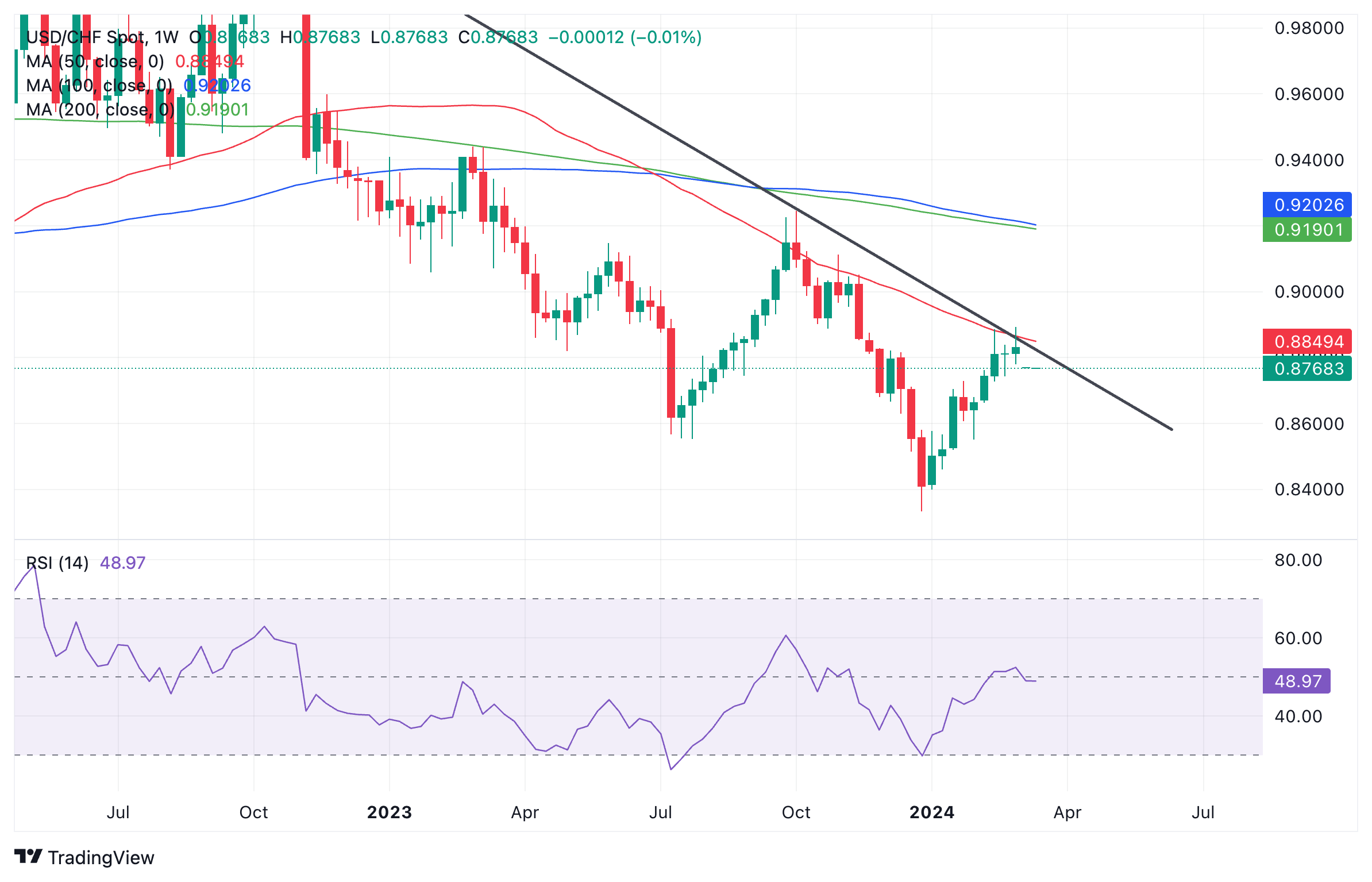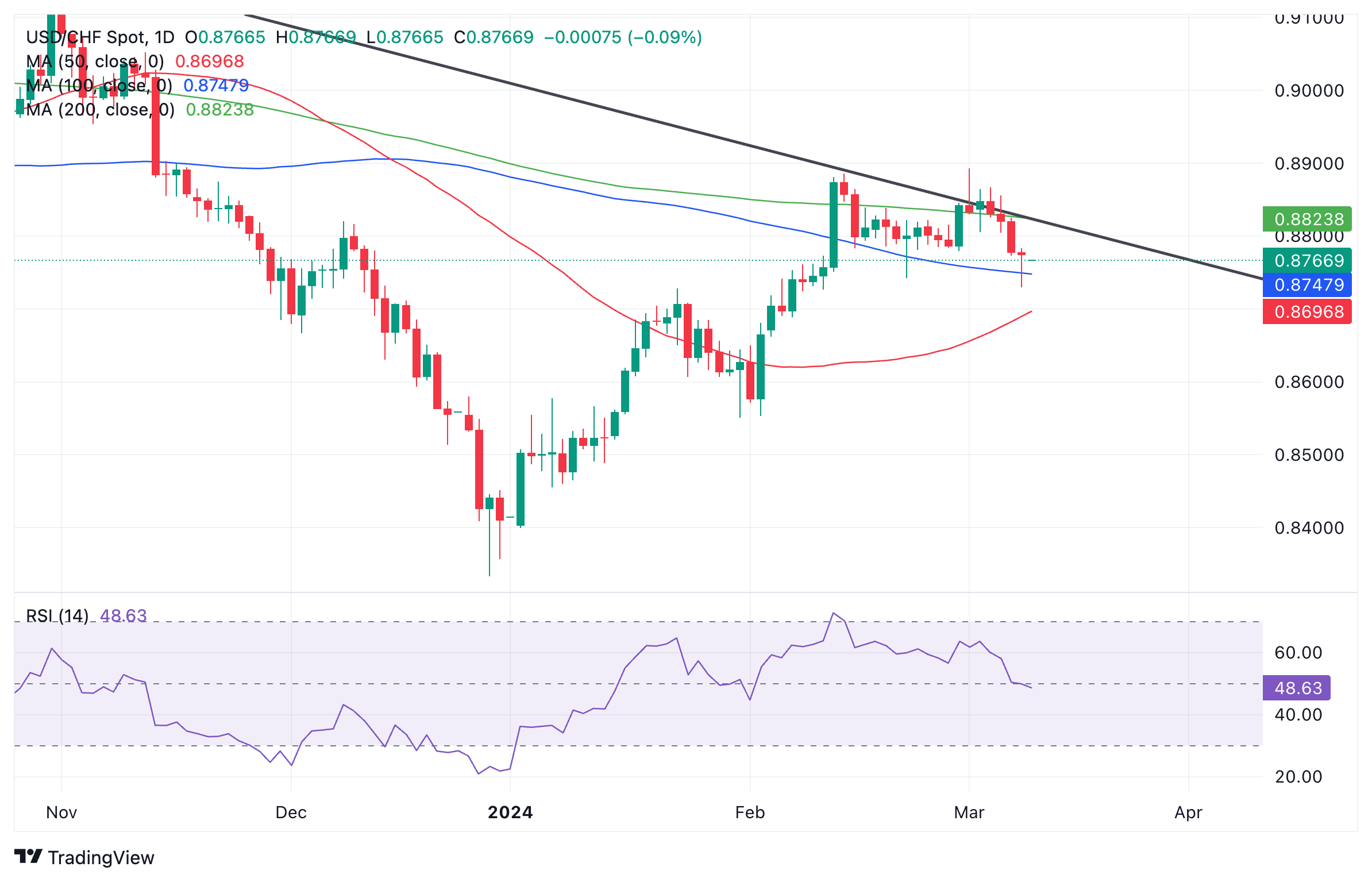Swiss Franc edges lower against US Dollar on Monday

- The Swiss Franc edges lower versus the USD after after initially rising on risk aversion hitting global stocks.
- The Swiss Franc is the go-to safe haven when investors become fearful.
- USD/CHF has turned lower after touching a key resistance level on the weekly charts.
The Swiss Franc (CHF) is edging down against the US Dollar (USD) on Monday, after a strong start when it capitalised on its safe-haven status. Global equity markets, a key barometer of risk appetite, are falling on uncertainty over the economic outlook, news of another China property bailout and over-valuation concerns. Most European equities are down by over half a percentage point and US indices are also in the red as Wall Street gets underway.
Swiss Franc vulnerable, HSBC says
Swiss Franc is likely to depreciate in the near term, according to analysts at HSBC, who see the Swiss National Bank’s (SNB) reluctance to implement policies to strengthen the Franc as well as an environment of overall uptrending equity markets as key headwinds.
In an interview with Bloomberg in February, SNB Chairman Thomas Jordan said the Swiss Franc might now be too strong. The CHF, he said, had been rising in nominal terms for several years, and that this had been “helpful” as it had “shielded us from inflationary pressures from abroad.” Jordan added, however, that at the end of 2023 the Franc had started to rise in real terms, and that this could be a problem for Swiss businesses.
Recent lower-than-expected core inflation data in Switzerland, which fell to 1.1% in February – lower than the 1.2% previous – further suggests the SNB will not need to raise interest rates.
On the Horizon
The next key event for the USD/CHF is the US Consumer Price Index (CPI) data for February, published on Tuesday at 12:30 GMT.
The Consumer Price Index ex Food and Energy is forecast to moderate to 3.7% YoY – from 3.9% previously, and 0.3% MoM from 0.4% previously.
The headline CPI figure is forecast to come in at 3.1% YoY, unchanged from the previous month, and at 0.4% MoM from 0.3% in the previous month.
The result of the CPI data will be key in factoring into when the Federal Reserve (Fed) is expected to start cutting interest rates. A lower-than-expected result could lead to earlier rate cuts from the Fed, which would have a negative impact on USD as it reduces foreign capital inflows.
According to the CME FedWatch Tool, which calculates a market-based expectation of when the Fed will begin reducing its Fed Funds Rate, the probability of a first cut in March is 4%, in May 31.5%, and the chances of a cut by June are 73.8%.
Technical Analysis: Swiss Franc vs US Dollar turns lower after touching key resistance level
The USD/CHF – the number of Swiss Francs one US Dollar can buy – is bumping up against several key technical levels on the charts which could point to the start of a reversal back down in line with the long-term downtrend.
The weekly chart shows the price currently butting up against the falling trendline of a descending channel, as well as the key 50-week Simple Moving Average (SMA). It is possible this could mark the inflection point of a reversal where the pair starts moving down again within the falling channel.
US Dollar vs Swiss Franc: weekly chart
The daily chart shows the battle at the resistance levels highlighted above, in more detail. The pair has pulled back from the channel line and weekly MA. It has also pierced below the February 22 low of 0.8742 on an intraday basis, suggesting the possibility of a deeper decline to 0.8645. A break below that level would solidify a reversal in the short-term trend and a bearish bias. The next target down if 0.8645 is breached would be the support level at January 31 lows of 0.8551.
US Dollar vs Swiss Franc: daily chart
There is now a good chance that price has reversed its uptrend. However, there is still also a fairly strong possibility it could recover and resume its trend higher. A break above the 0.8892 high would indicate a continuation of the short-term uptrend to a possible target at 0.9056.
Fed FAQs
Monetary policy in the US is shaped by the Federal Reserve (Fed). The Fed has two mandates: to achieve price stability and foster full employment. Its primary tool to achieve these goals is by adjusting interest rates. When prices are rising too quickly and inflation is above the Fed’s 2% target, it raises interest rates, increasing borrowing costs throughout the economy. This results in a stronger US Dollar (USD) as it makes the US a more attractive place for international investors to park their money. When inflation falls below 2% or the Unemployment Rate is too high, the Fed may lower interest rates to encourage borrowing, which weighs on the Greenback.
The Federal Reserve (Fed) holds eight policy meetings a year, where the Federal Open Market Committee (FOMC) assesses economic conditions and makes monetary policy decisions. The FOMC is attended by twelve Fed officials – the seven members of the Board of Governors, the president of the Federal Reserve Bank of New York, and four of the remaining eleven regional Reserve Bank presidents, who serve one-year terms on a rotating basis.
In extreme situations, the Federal Reserve may resort to a policy named Quantitative Easing (QE). QE is the process by which the Fed substantially increases the flow of credit in a stuck financial system. It is a non-standard policy measure used during crises or when inflation is extremely low. It was the Fed’s weapon of choice during the Great Financial Crisis in 2008. It involves the Fed printing more Dollars and using them to buy high grade bonds from financial institutions. QE usually weakens the US Dollar.
Quantitative tightening (QT) is the reverse process of QE, whereby the Federal Reserve stops buying bonds from financial institutions and does not reinvest the principal from the bonds it holds maturing, to purchase new bonds. It is usually positive for the value of the US Dollar.

